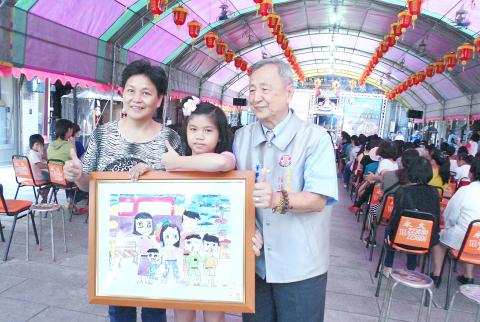Due to family circumstances, Hsu Fang-yu, a fourth-grade student at Chiayi Municipal Ta-tung Elementary School, lives with her grandmother, who makes a living from collecting items for recycling, and her great-grandmother. Hsu likes drawing. By chance, she found some wax crayons among the things her grandmother had collected for recycling, learning by herself, she found something she was very good at. In the third grade at elementary school, she was admitted to a class for artistically gifted children. On Sept. 19 she received a commendation as an “angel in adversity” from the Chiayi Cheng-huang Temple’s charity foundation. Hsu attended the prize-giving activity along with her grandmother and took along a drawing she had done of her whole family. The story of how she has made advances in spite of adversity is quite moving.
Hsu says that her mother looks after her two younger brothers, who are late developers, on her own in Taichung, so she, her 56-year-old grandmother and 93-year-old great-grandmother have to depend on one another. Apart from a military pension, their household income is supplemented by her grandmother’s earnings from recycling. Hsu helps with collecting and sorting things for recycling, and the stationery and drawing materials she uses are picked out from among the recyclables.
The girl’s grandmother, Wang Ching-chung, says that when Hsu gets home she helps by hanging clothes out to dry, bringing them in again and sweeping and mopping the floor. When her great-grandmother goes out, she always walks along with her and gives her a helping hand. Although she lives in a poor household, Hsu is resilient and hardworking, and she is very respectful and obedient. They are lucky to have such a well-behaved little girl, says Wang.
(Liberty Times, translated by Julian Clegg)

Photo: Ting Wei-chieh, Liberty Times
照片:自由時報記者丁偉杰
嘉義市大同國小四年級學生許芳瑜,因家庭因素,跟著從事資源回收的祖母以及曾祖母同住。她喜歡畫畫,無意間從祖母撿回的資源回收物找到蠟筆,靠著自學,畫出一片天,小三考進美術資優班,九月十九日接受嘉義城隍廟慈善會「逆境天使」表揚,許芳瑜與祖母一起出席授獎活動,還帶來一幅「全家福」畫作。逆境向上的故事,讓人感動。
許芳瑜說,因媽媽在台中獨力照顧兩個發展遲緩的弟弟,她必須跟五十六歲祖母,及高齡九十三歲曾祖母相依為命;家裡生活開銷除領榮民撫恤金,另由祖母從事資源回收補貼家用。她會幫忙回收、分類,所用的文具及畫具都是從回收物挑選而來。
祖母王敬忠說,芳瑜放學回家會幫忙曬衣服、收衣服、掃地、擦地;阿祖外出,一定跟前跟後,攙扶阿祖。雖然家境清寒,芳瑜刻苦努力,十分孝順,非常難得。
(自由時報記者丁偉杰)

The content recommendation algorithm that powers the online short video platform TikTok has once again come under the spotlight after the app’s Chinese owner ByteDance signed binding agreements to form a joint venture that will hand control of operations of TikTok’s US app to American and global investors, including cloud computing company Oracle. Here is what we know so far about its fate, following the establishment of the joint venture. IS BYTEDANCE CEDING CONTROL? While the creation of this new entity marks a big step toward avoiding a US ban, as well as easing trade and tech-related tensions between Washington and Beijing, there

A: Happy New Year! I can’t believe it’s 2026 already. Where did you count down? B: I went to pop singer A-mei’s Taitung concert yesterday for the New Year’s countdown. How about you? A: I went to rock band Mayday’s Taichung concert yesterday. Going to their New Year’s shows has become a holiday tradition for me. B: Don’t forget, we’re also going to Jolin Tsai’s show tonight. It’s her first perfomance at the Taipei Dome. A: Yeah, that’s right. It’s great to start the year with good friends and good music. A: 新年快樂!我真不敢相信都已經2026年了。你昨天去哪跨年啦? B: 我昨天去了流行天后張惠妹的台東演唱會,還和她一起跨年倒數。那你呢? A:

Prompted by military threats from Russia, Denmark has recently passed a new conscription law, officially including women in its military draft for the first time. From July 1, 2025, Danish women, upon turning 18, will be entered into the draft lottery. If selected, they are to serve in the military for 11 months, just as men do. Not only has this decision attracted international attention, but it has also sparked discussions on gender, equality and national defense. Although Denmark’s reform appears to promote gender equality, it primarily responds to regional instability and the need to strengthen national defense. With

A: Apart from Taiwan’s A-mei, Mayday and Jolin Tsai, there are many foreign singers coming to Taiwan early this year. B: The South Korean girl group Babymonster are playing two shows at Taipei Arena starting from tonight. Who else is coming to Taiwan? A: Other artists include Australian band Air Supply, K-pop superstar Rain, boy group Super Junior, TXT, US singers Giveon and Josh Groban, and Irish boy group Westlife. B: Air Supply was the first foreign band to come to Taiwan in 1983, and they’re probably the most frequently visiting group too. A: As the year is beginning